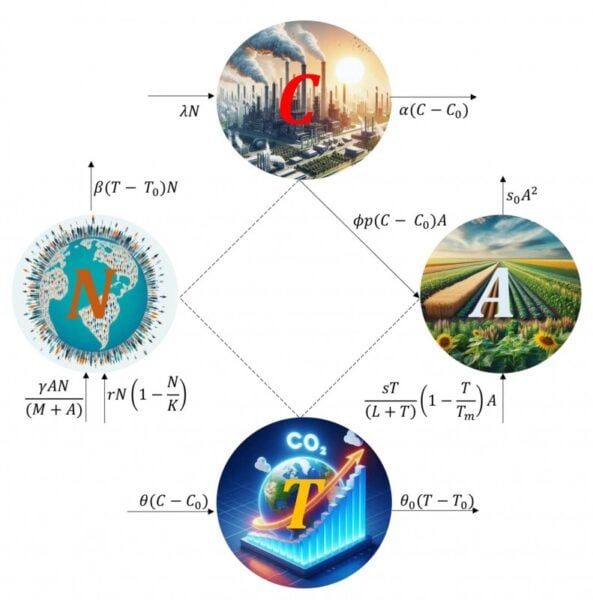As carbon dioxide levels continue to rise in our atmosphere, scientists have uncovered a crucial tipping point that could determine the future of global food production. New research using advanced mathematical modeling shows that while plants initially benefit from increased CO2 levels, this advantage disappears once temperatures cross a critical threshold—a finding that carries significant implications for worldwide food security.
Published in Chaos | Estimated reading time: 4 minutes
The delicate balance between atmospheric carbon dioxide and crop yields presents a complex puzzle that researchers at Banaras Hindu University have worked to decode. Their innovative mathematical approach reveals both opportunities and challenges in adapting agriculture to our changing climate, while highlighting the urgent need to develop heat-resistant crop varieties.
The research team developed a sophisticated model that captures the intricate dance between rising CO2 levels, temperature changes, and crop productivity. “We’ve considered how the rising CO2 levels will initially boost crop growth through the ‘CO2 fertilization effect,’ but once temperatures exceed a critical threshold the heat stress will reduce yields,” explains lead researcher A.K. Misra. This dual effect creates a precarious balance that could determine the future of global food production.
The study’s findings paint a nuanced picture of agriculture’s future. While elevated CO2 levels can initially act as a fertilizer, promoting plant growth, this benefit comes with a crucial caveat. The accompanying temperature increases eventually reach a tipping point where heat stress begins to diminish crop yields—a threshold that varies among different crop varieties.
Perhaps most striking is the model’s revelation of complex seasonal patterns and chaotic behaviors in crop responses to climate change. These patterns suggest that the impact of rising temperatures on agriculture may be more unpredictable than previously thought, requiring sophisticated adaptation strategies.
The research points to a promising path forward: developing crops with enhanced temperature tolerance. “Our findings suggest breeding or using crops with increased temperature tolerance should be considered as a strategy to maintain productivity under elevated CO2 levels,” Misra notes. This approach could help maintain food production even as global temperatures continue to rise.
The team’s next steps involve expanding their model to account for additional variables such as insect populations, water availability, and soil quality—factors that could further influence crop yields in a changing climate. They also plan to develop region-specific models to enable more localized predictions and strategies.
Glossary
- CO2 fertilization effect: The temporary boost in plant growth that occurs when atmospheric carbon dioxide levels increase
- Autonomous systems: Mathematical models that don’t explicitly depend on time, used to study general patterns
- Nonautonomous systems: Mathematical models that include time-dependent variations, such as seasonal changes
What happens to crop yields when CO2 levels first begin to rise?
Initially, crops experience increased growth due to the CO2 fertilization effect, but this benefit diminishes once temperatures exceed a critical threshold.
Why did the researchers use both autonomous and nonautonomous models?
To capture both general patterns and seasonal variations in crop responses to climate change, revealing complex behaviors like periodic oscillations and chaos.
What solution does the research suggest for maintaining crop yields?
Developing crop varieties with higher temperature tolerance to better withstand the heat stress associated with rising CO2 levels.
What additional factors will the researchers study next?
They plan to incorporate variables such as insect populations, water availability, soil quality, and nutrient levels into their model.
Enjoy this story? Subscribe to our newsletter at scienceblog.substack.com.


